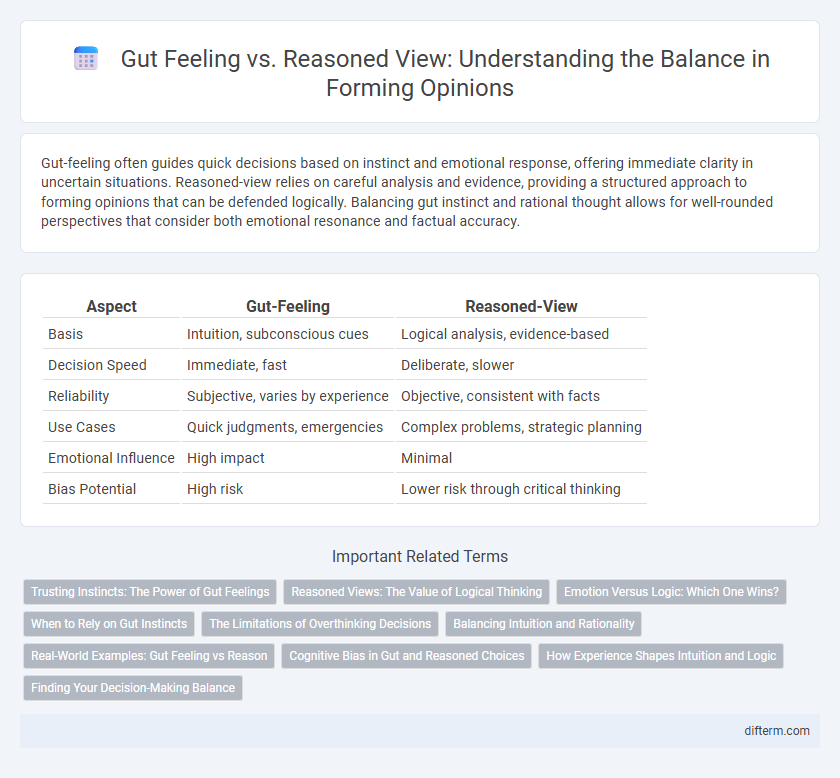Gut-feeling often guides quick decisions based on instinct and emotional response, offering immediate clarity in uncertain situations. Reasoned-view relies on careful analysis and evidence, providing a structured approach to forming opinions that can be defended logically. Balancing gut instinct and rational thought allows for well-rounded perspectives that consider both emotional resonance and factual accuracy.
Table of Comparison
| Aspect | Gut-Feeling | Reasoned-View |
|---|---|---|
| Basis | Intuition, subconscious cues | Logical analysis, evidence-based |
| Decision Speed | Immediate, fast | Deliberate, slower |
| Reliability | Subjective, varies by experience | Objective, consistent with facts |
| Use Cases | Quick judgments, emergencies | Complex problems, strategic planning |
| Emotional Influence | High impact | Minimal |
| Bias Potential | High risk | Lower risk through critical thinking |
Trusting Instincts: The Power of Gut Feelings
Gut feelings serve as rapid, subconscious assessments rooted in accumulated experiences, often guiding decisions more effectively than deliberate analysis in uncertain situations. Studies in neuroscience reveal that intuition activates brain regions linked to emotion and memory, reinforcing the reliability of gut instincts in complex problem-solving. While reasoned views provide structured evaluation, trusting instincts can harness an individual's tacit knowledge, leading to swift and adaptive choices.
Reasoned Views: The Value of Logical Thinking
Reasoned views offer a structured approach to decision-making by relying on evidence, critical analysis, and logical consistency. This method minimizes biases and emotional influences, leading to more reliable and replicable conclusions. Emphasizing logical thinking cultivates clearer problem-solving skills and fosters informed opinions grounded in objective facts.
Emotion Versus Logic: Which One Wins?
Gut feeling often triggers swift, emotion-based decisions driven by subconscious cues, while reasoned view relies on deliberate analysis and factual evidence for problem-solving. Neuroscientific studies show that the brain's amygdala activates during emotional responses, influencing immediate judgments, whereas the prefrontal cortex governs logical reasoning and critical thinking. Balancing emotional intuition with logical assessment tends to produce more comprehensive and effective decision-making outcomes.
When to Rely on Gut Instincts
Gut instincts often provide rapid, subconscious insights rooted in accumulated experiences, making them invaluable in high-pressure situations requiring immediate decisions, such as emergency response or quick negotiations. Reasoned views excel when ample data and time allow for thorough analysis, but gut feelings can signal when to trust intuition over overthinking. Prioritizing gut instincts becomes essential when patterns are recognized unconsciously, enabling efficient judgment where logic may falter or delay action.
The Limitations of Overthinking Decisions
Overthinking decisions often leads to analysis paralysis, where excessive scrutiny causes delays and missed opportunities. Gut feelings tap into subconscious patterns and experiences, providing swift, intuitive judgments that reasoned views may overlook. Recognizing the limitations of overanalyzing allows for a balanced approach, blending instinct with rational evaluation for better decision-making outcomes.
Balancing Intuition and Rationality
Balancing gut-feeling and reasoned view enhances decision-making by integrating instinctive insights with logical analysis, leading to more nuanced outcomes. Gut-feelings, rooted in subconscious pattern recognition, offer quick judgments while rationality ensures deliberate evaluation of evidence and potential consequences. Effective decision-makers cultivate awareness of when to trust intuition versus when to apply critical thinking, optimizing cognitive resources for complex challenges.
Real-World Examples: Gut Feeling vs Reason
Gut feeling often drives split-second decisions in high-pressure environments like emergency medical response, where intuition based on experience can save lives more effectively than detailed analysis. In contrast, reasoned views excel in strategic business planning, where data-driven models and careful evaluation of market trends reduce risks and enhance long-term success. Real-world examples from industries such as healthcare and finance demonstrate that balancing intuition with reason leads to optimal decision-making outcomes.
Cognitive Bias in Gut and Reasoned Choices
Gut-feeling decisions often fall prey to cognitive biases such as anchoring, availability heuristics, and confirmation bias, which can distort perception and judgment. Reasoned choices, when supported by critical thinking and evidence evaluation, help mitigate these biases by promoting objectivity and reflection. Understanding the interplay between intuition and analytical reasoning is crucial for improving decision-making accuracy and avoiding systematic errors.
How Experience Shapes Intuition and Logic
Experience fundamentally shapes intuition by allowing the brain to recognize patterns and make swift decisions without conscious reasoning. Over time, repeated exposure to similar situations enhances gut feelings with a nuanced understanding derived from accumulated knowledge. Conversely, reasoned views rely on deliberate analysis, but experience enriches this process by providing relevant context and practical insights that inform logical conclusions.
Finding Your Decision-Making Balance
Gut-feeling offers instinctive insights rooted in subconscious experience, while reasoned-view relies on logical analysis and evidence to guide choices. Balancing these approaches enhances decision-making by combining emotional intelligence with critical thinking skills. Mastering this equilibrium allows individuals to navigate complex situations effectively, leveraging both intuition and rationality for optimal outcomes.
gut-feeling vs reasoned-view Infographic

 difterm.com
difterm.com